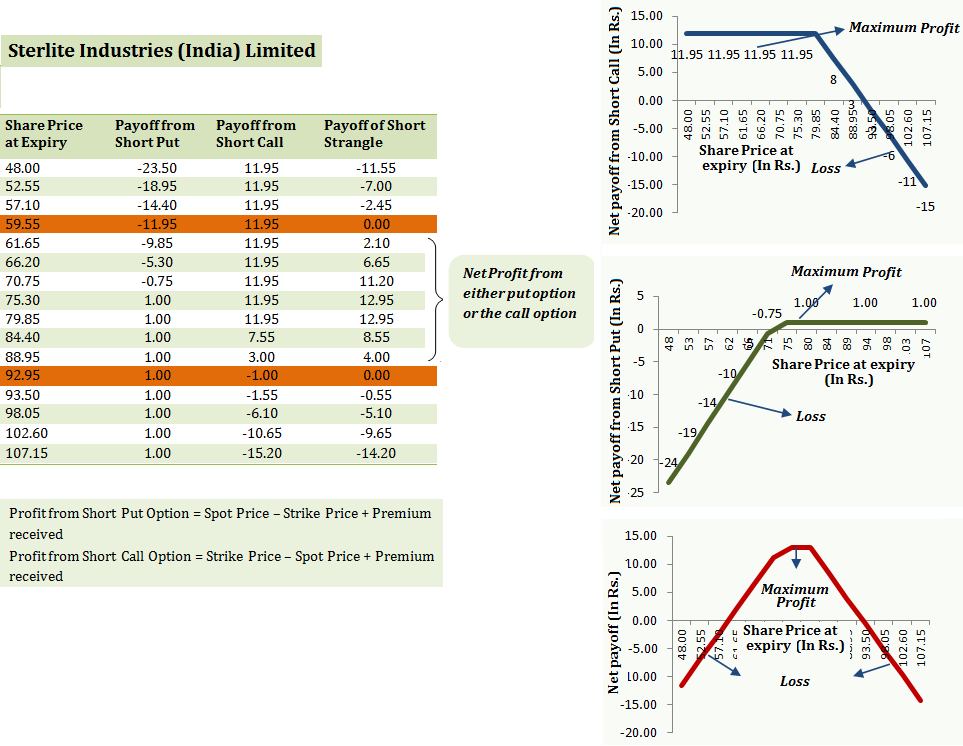When to use: Short Strangle Option Strategy is used when the investor believes that the stock is not very volatile and that the stock price will not change much before the expiry date. The intention is to earn an option premium on two options at the same time.
How it works: In the short strangle option strategy you sell an out-of-the-money call option and an out-of-the-money put option of the same stock with the same expiration date, T.
For example: On 16th August 2013, when the share of Sterlite Industries was trading at Rs. 75.85, you sell/write an out-of-the-money call option at a premium of Rs 11.95 with a strike price of Rs. 80.00 and an out-of-the-money put option at a premium of Rs. 1.00 with a strike price of Rs. 72.50, expiring 26th September 2013.
Risk/Reward: In a short strangle option strategy, the risk is unlimited and the reward/profit is limited to the amount of net premium received.
For Call Option: If the price of Sterlite Industries stays below Rs. 80.00 (i.e. the strike price), until expiry, you will retain the entire premium amount (i.e. Rs. 11.95). If however the price rises above Rs. 80.00, the buyer of call option may exercise his option and make a profit based on how far above Rs. 80.00 does the stock price rise. From the perspective of the seller of the call (you), you will start suffering a loss once the stock price rises above Rs. 91.95 (i.e. the strike price + premium received).
For Put Option: If the price of the share stays below Rs. 72.50 (i.e. the strike price) until expiry, you will retain the entire premium amount (i.e. Rs. 1.00). If however the price falls below Rs. 72.50, the buyer of put option may exercise his option. Once the price falls below Rs. 71.50, the buyer of put option will start making a profit based on how far below Rs. 71.50 does the stock price fall. From the perspective of the seller of the put (you), you will start suffering a loss once the stock price falls below Rs. 71.50 (i.e. the strike price – premium paid).
In order for the short strangle option strategy to realise profit at expiry, the stock must be above Rs. 59.55 or below Rs. 92.95. The table below show the net payoff of short strangle at different spot prices upon expiry.
(click to enlarge)
The table above allows you to easily see the break-even points, maximum profit and the loss potential at expiry in rupee terms.
The two break-even points occur when the price of the underlying share equals Rs. 59.55 and Rs. 92.95.
Upper Breakeven = Strike price of Call option+ net premium received = Rs. 92.95 (80 +12.95)
Lower Breakeven = Strike price of Put option – net premium paid = Rs. 59.55 (72.50 – 12.95)
How to use the Short Strangle Option Excel calculator
Just enter your expected spot price on expiry, option strike price and the amount of premium, to estimate your net pay-off from the Short Strangle Option Strategy.
Note: The example and calculations are based assuming a single share though in reality options are based on lots of many shares. For example Sterlite option contract is for 4000 shares. Accordingly the premium you receive will be Rs. 51,800 for 2 lots (i.e. 11.95 *4000 + 1.00*4000) in our example.
Also Note: Unlike the buyer of an option who only pays the premium to buy the option, the seller of an option must deposit a margin amount with the exchange. This is because he practically takes an unlimited risk as the stock price may fall to any level (up to zero). In case the price falls sharply below the strike price, the exchange utilises the margin amount to make good the profit which the option buyer makes. The amount of margin is decided by the exchange and it typically ranges from 15 % to 60 % based on the volatility in the underlying stock and market conditions. In the above example, as a seller of put option and call option, you will have to deposit a margin of Rs. 92,903 (i.e. Strike price * Lot size * 15.23%) for selling/writing 2 lot of Sterlite Industries’ put option and call option. Note that the total value of your outstanding position in this case will be Rs. 6,10,000 (i.e. strike price * lot size).




Hi thanks for explaining. it was very clear and helped me to understand. Your website is a source of a lot of good information about options trading in India.. It would be more helpful if you write about equity too.
Hi Das – that’s primarily what I write about. Look around.